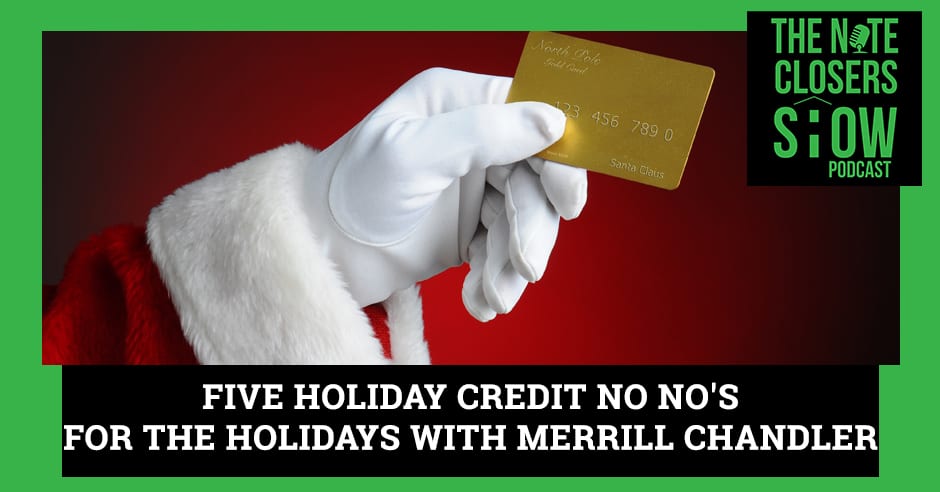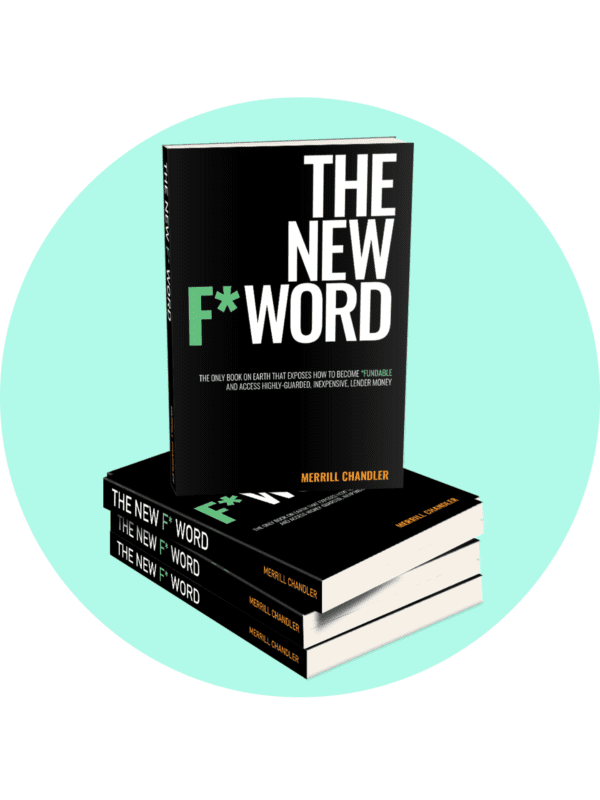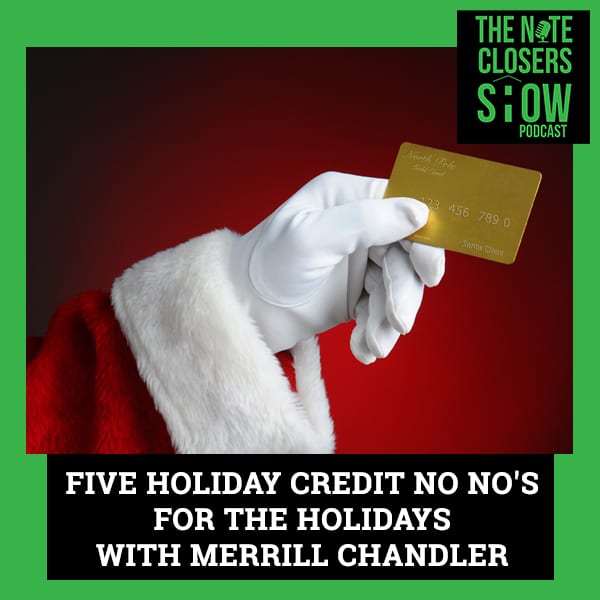
Getting your credit score up to a desirable figure is arduous work, then you put in more effort to keep it that way. To save you from all these troubles, the Founder, CEO, and Chief Strategist of Get Fundable, Merrill Chandler, shares his knowledge on the things you need to do in order to avoid taking hits on your credit. He doesn’t only list some vague tips and strategies but discuss in great detail the why, how, and what of each strategy he personally uses and teaches his clients. Learn how your credit behaves and reacts to your actions, and you’ll never be in fear of having bad credit again.
—
Watch the episode here
Listen to the podcast here
Five Holiday Credit No No’s For The Holidays with Merrill Chandler
I’m excited to be here and even more jacked up. We have our regular guest on here who was literally lighting the world on fire as we speak. We’re talking about our good buddy, our brother from another mother, the Neo of the credit world and the credit god, I should say. He is doing some amazing things. His podcast, Are You F*able, is blowing up. He’s got a new book out, The New F* Word that went to print. I’m excited about the man, the myth, the legend, Mr. Merrill Chandler of FundingHackers.com.
I can’t even tell you that is the best introduction ever. It is on fire. There are many things hitting that had been culminating for months. I’m excited to be here to share the love and the good news.
Most people are dragging to the end of the year.
I would love to believe I’m still f*able and my job is to make sure that every single person who read your podcast and mine knows how to become f*able themselves. I have quick story I got to tell you. I did a podcast episode with my oldest daughter. She is 31 and she’s the one I always brag about that from 18 on, we started building a perfect profile. It was funny. I’m sitting there and I closed out my show saying, “I want your children to be as f*able as mine are.” I was like, “I’m Merrill, but is that even appropriate?”
Not in some circles, but in this circle, since we were talking about fundable versus the other F word.
We are talking about fundable always and only.
Everybody that’s reading across note nation, across the radio network and the 96 countries that people are reading the blog in a regular basis, which is funny. We added a new country this last month. We were talking about what to focus on and talk about this episode and last time, you blew away the doors talking about everything that you learned from FICO World in New York and all the great stuff there. I love what you’re doing with the podcast and what you’ve got rolling out there. Let’s talk about not the five golden rings, but maybe the five biggest mistakes people are making on the holiday season when it comes to their credit and being fundable.
Destroying Your Credit Profile For A Discount
There are some debt dealing things you can do and we’re always tempted at the holiday season. We stack up. Some people save, other people raise credit limits. There are two different strategies, but let’s go over some of these fundability-killing things that we could do, the landmines we can step on. The first thing that I want to talk about is the one that I talk about in my bootcamp, but it is notorious and that’s how to destroy your credit profile and save 10% on your next purchase. They’re only mall store cards. Your Chase isn’t doing this. Wells Fargo isn’t doing this. When you go to mall stores, retail merchants, they’re going to offer you 10% and sometimes 15% to 20% during the holidays. They’re going to take it off if you fill out an application.
Filling out the application, literally there’s hurt and there’s harm and it’s going to harm your credit profile in three ways. One, you’re going to get 3 to 15 points deduction in your score for the inquiry. Whether you’re approved or not, you’re going to take a hit. The second thing you’re going to hit on is that if you’re approved, you’re going to lower the average age of your revolving accounts of your credit cards. Let me illustrate what that means. Let’s say you have two credit cards, one of them is 60 months old and one of them is twenty months old. That’s a total of 80 months.
If you go out and get one of these new cards and it’s a zero month, 80 plus 0, your entire portfolio average age is 40 months old because 80 divided by 3 is going to be 26 months, whereas before you’re 40 and 20 was 30 months old. You dropped the average age. The thresholds are 2, 3, 6, 11 and 25 years. If you go through that 36 months and you go below that, your entire revolving accounts, your entire credit card portfolio suffers. If you do it 1 maybe 2 or 3 times, you’re literally adding all of these factors that are going to reduce the value of how fundable you are. I understand what we have to do in order to survive, to give our children and our families a good Christmas. I understand all those things, but know I want you to make these choices based on how much it’s going to cost you because I don’t care what you do, as long as you’re aware of what the price you’re going to pay. This is one of those things that is deadly for your profile.
The third thing that harms your profile is the card you get accepted for is the junk card. It’s a 40% tier four garbage card. No lender is going to give you a $50,000 business line of credit on your Buckle or Victoria’s Secret or Home Depot or limited credit card reputation. Those are the three ways that is going to harm you. If you accept that offer and unless you’re spending $60,000, maybe we can figure out a way. If you’re spending $60,000 at Target, you’re going to save $6,000 to $9,000 then let’s figure out something to do about that. Otherwise to save to $20 or $30 or $50, it’s not worth the price you’re going to pay over your fundability.
We see that everywhere we go. We see that at all of the stores that offer it up there. I would say it has replaced the get-your-free-tee-shirt-and-sign-up-on-a-college-campus kind of thing, which has gotten a lot of students early on.
What they’re doing is huge.
That’s the first thing, don’t sign up for the crappo cards to save you 10%. They’ll save you 10% to ruin your credit for months.

Credit Fundability: Filling out or requesting to fill out applications for mall store cards’ discount will hurt your credit profile.
Raising Your Limit
Yes, for years. Once it’s on there, then turning it off or shutting it down will negatively hit your profile as well. Number two, another big one is that shoppers tend to want to raise their limits so they can do more shopping.
This is number two and number three, because raising your limits is bad juju. The other thing is number three, when you raise your limits, you have a tendency to raise two other factors. One, you’re going to raise your utilization when your balances go up. It’s harmful. Let’s look at the 24-month look back period. Let’s say that we’re going all techie on this one because that’s where the juice is of this time. Let’s say for the last 24 months, you’ve had $10,000 worth of credit limits. FICO measures over the last 24 months how many limits you have. You’ve got $10,000 worth of limits. It’s been consistent. If all of a sudden you go raise the limits on 2 or 3 cards that make up that $10,000 and you go to $12,000 or $13,000 or 15,000, the limit increase itself could trigger a red flag against your profile.
The reason is that you’ve had this long history of doing nothing and then all of a sudden you need money. It’s a bad message to send and that’s going to trigger you. Again, that message is going to harm your profile because you’re looking at needing money. You didn’t do another $1,000 every six months to grow it. You jacked it all up at one thing. That’s number two is raising your limits too fast, too quickly is going to send red flags to your fundability.
Too Much To Spend
Number three is associated with it. When you have that higher limit, depending on your profile, you may have what’s called too much available credit. You can have too big balances, too high balances and you could have too high limits. The ratio between those, we teach it at the bootcamp and everything. It’s in my book but you have to keep your balances down and your limits within a certain percentage of your income. I don’t know what it is for each one of you because that percentage of your income is based on your profile quality. What’s your total debt load? What’s your total limit load? Every single borrower, every single one of you reading, there is a perfect limit number of limits and anything above that is too much available credit and you’re going to get hit.
To go with that, when we raise our limits, most of the time we give ourselves an opportunity or an excuse to raise our balances and that’s where utilization will kill us through and through. We’ll pull the rug out from underneath this because especially if we’ve had X balances, I don’t care if you’re carrying 7% or 20% or 30%, whatever it is you’re carrying. If you all of a sudden jacked it to 2 or 3 times that 10% to 20%, 20% to 40%, 40% to 80%, you’re triggering FICO and lender protection strategies. We run across in the holiday seasons people whose cards get shut down or people whose limits get lowered right out from underneath them. You raise your limit, you shop, let’s say you raise your limit.
We had this happen with one of our clients, they raised their limit from $10,000 to $15,000 and then their balances were $2,000 to $3,000 but they put eight total on the credit card and then the credit card company which I believe is Wells Fargo literally shut it down to $6,000. They’re upside down in their credit line and their credit limit simply because they raised the limit after without doing it methodically. They raised the balance without doing it intelligently or methodically in a fundable way and all of a sudden you scare the algorithm and it’s like the stock show, the computer traders and the automatic traders where do they sell at this and buy at those.
The algorithm is kicked all the way down.
All those things happen that the lender underwriting software is triggered by too much of a balance increase, too much of a limit increase and they will shut down. Your host, you just did a short-term pleasure gain with holiday seasons or shopping or traveling or whatever it is you need to do. If you don’t do it well intelligently and play that funding game, you can risk the entire limit. It could be ten years old, that credit card, and it may lower the limit or shut it down because you have done that too much, too fast. That was a big one.
Say no when they offer you, “Would you like to take 10% of your purchase a day at Kohl’s for the holidays?” That’s the first thing. Don’t do that because it affects you right away. Secondly, don’t go and increase your credit limits by calling and doing that. Don’t go and then spend more because they’re going to say no to you and reduce your limits.
Business Side
Those are the big ones. With the combination of raising limits and then raising balances, you’re literally telling the very worst possible news to your lender, to your credit card issuer. You’re saying, “I need more money and I’m going to spend it the second you give it to me.” That’s the worst thing we could possibly do. Number four, if you’re going to do it, do everything we talked about on the business side. Buy your Christmas gifts with a business credit card and then deed them over so that there’s no piercing of the corporate veil. Lend the money to you personally from the business. Buy something that you have to do. Do it on the business side. That’s not affecting your personal profile, that goose that lays the golden egg. Number four is if you have to do one of those things, make sure that you get a business instrument.
We have to be careful on the business side because I don’t want to say it’s free for all, the Wild Wild West on the business because you still have to nurture the relationship with American Express or Chase or whoever your business card is with. Whatever happens on the business side doesn’t harm the entire messaging Panorama of the personal. That’s your funding engine. Let’s say you ruined the relationship of Chase business. You’re not ruining all of the relationships over by wreaking havoc on the personal side.
We also take into effect that a lot of times, these businesses are having larger expenditures at the end of the year with profits.
Balances Are Everything
That’s a great point because point number five that I always go through is the thing to watch out for but it can be positive. We’re at the end of the year, you know how the US government spends its budget. They are like, “To get our budget renewed, we got to buy 4,200 desks because we don’t know what else to buy.” It’s the same for us. People come to me for coaching and December is a huge month for us because if you buy one of our coaching packages, you literally get to write the entire face value off. Even if you’re paying it for a year over installment, you get to write off the full face amount of your coaching. It’s the same thing on purchases. Businesses are going to be ramping up so they can get as many write-offs as possible at the end of the year. Whether those are Christmas presents or traveling to go visit family, do it on your business instruments wherever possible.
That makes a lot of sense for people out there. You use it. You do a major purchase, use your business cards and then pay cash to the business cards you just paid off there. If you can, it’s before the reporting date. Would you agree with that?
Yes. Ultimately, you want to get the balances down just like you would on the personal. If you have to carry a balance, the balances you carry on a true business credit card or credit instrument does not harm your personal profile. That’s what we’re trying to do. We’re trying to get through the holidays without cooking our golden goose. We’ve been taught to abuse and misuse our funding golden goose. I’m saying, that stops right now, right here on the Scott Carson show. Instead of freedom, it’s fundability.

Credit Fundability: Do what you want as long as you’re aware of the price you’re going to pay.
That’s the other F word. They can never take away our fundability.
That YouTube video, I need to dub over that and say, “They cannot take our fundability.” That’ll be awesome. You are the most creative soul. You give many great ideas. Thank you for the review. For you readers, those of you who have pre-purchased a book, if you haven’t The New F* word, it’s out. Go to GetFundable.com/Book and you will see Scott Carson’s review on my book. Not only are we mutual fans but he has gone through this tech himself. He’s applied this technology himself. He’s a living, breathing example of what can happen as a result of these things. Thank you so much for reviewing my book and giving me a review. It’s on the back cover.
I’m glad to do that, too. We’ll be doing one on Amazon. I have a question I wanted to ask you. As people are working on their personal credit line, they’re working on their personal to get everything in shape and the seizing issue you mentioned by having the months in place for new credit card. Is that a bad thing or isn’t it a good thing if they go to their major bank and take $1,000 and add a business-secured credit card? There’s a lot of times where businesses, especially the major banks, will do a secure door. We’ll take $1,000 from an account. That’s the limit you have but we’ll set it up under whatever entity you want, your LLC and starting that process. It has the business card that’s not attached to your personal credit. Is that a good thing to do to start of get that timing going?
Depending on your credit score and the quality of your profile, there are easier ways than doing a secured card. If you have a lower credit score and an unfundable profile on the personal side, then a secured card may be wise. Here’s the fascinating things straight out of the mouth of FICO. They do not calculate secured cards and unsecured cards differently in their modeling and here’s why. Even though there’s money backstopping the card, and this is what I preached in the book and wherever I go, they’re measuring the borrower’s behavior, not whether or not it’s safe for the bank to lend it to you. They’re measuring and qualifying you on the behavior. Somebody might say, “I’ve got $1,000 in there. I was backstopping it. I’m going to charge up $900.” You’re going to show in every metric on the universe that you have a 90% utilization, even though it’s safe for the lender. Yes, you can start those instruments personal or business with secured cards, but you cannot abuse the limits in the balances. That’s one of the things.
Also, keep in mind that ratio to keep it below if you’re going to be using it.
In fact, let’s go to number five of the things not to do. Number five is that balances are everything. I said don’t go jacking up your balances, especially if you’ve raised your limits but I’m going to give you the numbers. Thirty-eight percent is the highest you want a credit card to go. Let’s say you’ve been carrying $10,000 credit card limit and you’ve been tooling around. You don’t want to go over $3,800 in that credit card. If you raise that limit, we’ve already said that there’s a risk there, but it’s safer if you do not go over the 38% of the $15,000. I’m saying never go over 38%. Spread your purchases, your flights, your family activities, whatever it is. You need to spread it out so that no card goes over 38% because you go into the risk department the second you’re over 38%, whether you’ve had that card for 20 years or 2 months. Risk looks at certain balances as risky. The risk department reviews those balances. That’s what you want to do it. Even if you raise the limit, don’t go over that 38% because if you do, then you have three aggravating things. You’re raising the limit, charging it up past the 38% but the 38% also has a double trigger that you go into the risk department.
If you doubled your credit line from $10,000 to $20,000, let’s make simple math there. Don’t go above the 38%. Stay at that aspect there. $10,000, $3,800 then when you want to increase to $7,600, stay below there. Try to pay it down. The best case is if you can, use your other business lines of credit, business cards to do that stuff.
That’s the stuff and then offload. If you have to use it on the personal, if you can write a check from one of the credit lines we helped you get or a balance transfer, make sure that you move anything you can. Carry any balance you have to carry. Do it on the business side and you shall be rewarded. However, you’re playing the funding game, make sure you’re playing it the best you possibly can. I’m the first one to tell you, sometimes we got to do what we got to do and no harm, no foul. I’m trying to give you as much insight as to how it might hurt you or harm you given your particular situations. There you go.
There are some things that pop up at the end of the year that are good to take advantage of because one of the big things that we see a lot are to get the new trucks. We see often a lot of great deals on motor vehicles at the end of the year. The best time to buy is in December. You get the biggest discounts. They’re trying to move that inventory off their books. Are there some things they should consider when they’re looking at buying a new vehicle at the end of the year?
One thing that I like to tell my students and clients is that what you need to remember is one of the things there to move this is 0% interest. Here’s the problem with the 0% interest. Know what you’re doing before you go do it. Zero percent interest, the same manufacturers, the same dealers are offering either 0% interest or X dollars in rebate. Here’s what most people don’t know. When you get a 0% financing, that’s always by the captured finance company. GM is going to have Allied and Toyota motor credit and Nissan financing. The 0% are all tier four lenders and they’re not as high a quality of lenders when you’re trying to build a fundable profile, especially for business credit. That 0% is always offered there. What people don’t know is to get 0%, you have to have eight grade credit at least a 720. That’s 720 credit score, which is a paper for automobiles. The very rate you would get from your lending institution, your preapproval from a credit union or otherwise, that rebate is going to be the exact amount of interest that would be save by doing 0%. Are you with me? Am I making sense, Scott?
It’s a shell game of what you would save an interest on that they would deduct from the amount of the vehicle.
What serves us f*able is that we know that we’re going to go get a tier one or tier two loan and on a lesser amount than the amount that would be zero percentage is from a tier four. The tier four is a soul crushing contribution to your profile. Whereas a tier one or tier two, even a credit you need tier three is better than the tier four, but the money is identical for that same A-paper, tier one credit score. Most people don’t know, “I don’t want to pay interest.” You’re just paying the amount of the rebate. Go get a tier one, tier two or if you have, tier three loan on a lesser amount than would be in your 0% interest.
Is it also valuable that if they’re doing the financing, to put a little down and make your first payment, a sizable amount?
Yes, whether it’s zero money down or you put a little bit down, but if you make a 2, 3, 5 payments’ worth on the first payment, even within the first 90 days, if we can get your balance to go faster than the term is expiring, then you’re going to be ahead and you’re going to be sending an amazing message to your lenders. I like to get my clients and students down to 90% as fast as possible. Whether that’s the first payment, you make a full 10% or over 2 or 3 months as fast as you can get there ahead of your normal monthly payments, get to 90% as fast as possible and you will reap the benefits again from your astute fundable moves in this arena.

Credit Fundability: If you have a low credit score and an un-fundable profile on the personal side, a secured card may be wise.
That’s the big thing when you walk into a dealership. If you’re going to do that, figure out what the number is. Come to the bottom line on the vehicle cost, then reach out to your financial institution for financing.
Whatever you were going to use as the down, make it as your first payment and you scored mightily.
Is there anything else around the end of the year?
Other than what we said that the face value of any of your purchases that you finance are f*able. That covers most of the ones that I coach. I’m giving advanced-level coaching to your audience for what we teach our clients. Those are the big ones between the last half of November through the end of the year. What we coach our clients on is how to manage what they’re doing so that there’s as little impact as possible.
This is something we talked about during the Funding Hackers class. I know a lot of people are thinking about this stuff and how valuable having a mortgage on one’s account. I only bring this up because I had a student who owner financed a property and they were trying to get refinanced out and could not cut or get financing because they were not structured properly on some things. The big thing I was saying, and we agreed on this, is that we see all notes and property and there is nothing against your entity financing a property to you and then having that loan serviced by a third-party servicer. Madison is our servicer. I double checked this with them. They would only report it to one credit union. They are not going to report it to all three but having to report to one is better than none than zero. You’re technically paying yourself to build that credit line, to build that mortgage credit if you don’t have a mortgage on yourself.
If it shows up as a mortgage in that reporting system, you’ve got at least one. We don’t like to spread between 2 or 3 but something is better than nothing.
I only say that because I have zero mortgage credits on my line and it’s the one thing I’m doing beginning of the year.
For decades now, the only mortgages I’ve ever had have been investment properties. My lifestyle, I have a roommate. He’s the single largest, most successful million-dollar flipper in Salt Lake City. I live with him. I’m never going to buy a non-rental property again. Many mortgages on my credit report are all investment properties. I don’t have the lifestyle. I’m always on the road for three weekends of a month and everything. I have a good life. Also, we went to press on my book, The New F* Word. If you haven’t gotten your copy yet, seriously grab a copy, I’ll cover the cost of the book. If you guys will cover shipping the book is free and I want to get it into your hot little hand and let’s get fundable. That’s why we call the bootcamp that. There’s no excuse. We got the tools, we got the tech, and we know what needs to be done. Let’s do it. Let’s get fundable.
I can see people sitting around the fireplace, chestnuts roasting, open fire and the story of Credit Christmas being read all across the country.
Everybody who preorders, I am personally writing one of my Merrillisms and signing it for you. I have dozens and dozens of Merrillisms. It’ll be fascinating to see which one you get.
Let’s do a quick recap here before we let people get rocking and rolling. You get back to here because you’ve been a busy man in the last 48 hours running around long in the last 48 hours. Let’s talk about that. Say no to the 10% discount to use a credit card on 10% of your purchase. Stay below your 38% credit lines. Do not ask for a credit increase.
If you don’t have to, don’t ask for it.
That’s the last thing you want to do and then if you add it, you don’t want to use it immediately. You don’t want to have an abnormal credit purchasing thing. If you are going to purchase something and you have business credit lines, you use your business credit lines to save on your personal stuff. There were a couple other things we talked about.
If you’re going to buy a vehicle, don’t put money down if you don’t have to and then put your entire down payment as the first payment. That’s the exact opposite. That’s the positive effect of all the red flags. This is a checkered flag coming in. You will get amazing fundability points as a result of that strategy.

THE NEW F* WORD…NOW!
Also, say no to 0% financing over 72 months from your Dodge dealer, Toyota or who it might be. You’re approved with your credit tier one credit bank and it may be a little higher, but it’ll save you a lot of money in the long run especially when you put that big chunk down.
Take the interest savings in the rebate and then finance that amount.
Merrill, 2019 has been a crazy year for you.
I’ve been buried in this book for literally months so I cannot wait to get back out on the road and continue to teach people that there is a different way. You don’t have to be unfundable. You don’t have to be stuck. You can buy notes, you can buy real estate and you can take down properties if you have the financial instruments. To have the financial instruments, you need the reputation, the profile, the fundability and that’s what I’m here to make sure that you have. I want you to be f*able.
You also have the opportunity to go over wherever you read the blog and check out the Are You F*able podcast too that Merrill’s launched over. Are there any surprises on the podcast of what you’re getting feedback and readers?
It’s doing really well. I’m trying to stay ahead. I’m at three podcasts a week because I got so much to say and people are sitting there gobbling it up as we produce every new episode. I’m loving it.
You need to take some time to recharge those fundable batteries that you’ve got there.
Can I tell you how I’m going to do that and how much of a recharge it is? My kids and I were die hard Star Wars fans. We’re doing a 24-hour marathon of all the episodes from Christmas night, the 25th all the way through the day after Christmas, the 26th and then going to the new release live as a family. We are bringing in food. It’s a 24-hour marathon.
May the force be with you. That sounds definitely a lot of fun.
That’s how I’m playing Christmas. I get my kids on Christmas night. Other parts of the family have other times. It’s always been Christmas night for me and we thought, “Let’s blaze out. Let’s all take it off.” We’ve been planning this for months. It’s going to be a blast.
Thank you so much for being such a big part of the podcast and always bringing in great stuff to our readers out there and looking forward to 2020 and all the great stuff. Let’s go along with people who are taking advantage of that and implementing what you’re teaching and really changing the world one borrower at a time, as we like to say.
Thank you so much, Scott.
Thanks, Merrill.
—
That’s going to wrap it up for this episode. Take some notes of the to-do’s and then not to-do’s that Merrill shared with you when you’re out in your shopping experience and when you’re looking at stuff in stockings or buying stuff through the Christmas holidays. Be smart. Take action and learn. We’ll see you at the top.
Important Links:
- Are You F*able
- The New F* Word
- FundingHackers.com.
- GetFundable.com/book
- https://YouTu.be/HQf1ZgXsIhY
- http://GetFundable.com
About Merrill Chandler
 For over 25 years, Merrill Chandler, a co-founder of Lexington Law Firm, has been the pointy-edge-of-the-spear regarding the education of Borrowers in how to improve their borrowing opportunities and success.
For over 25 years, Merrill Chandler, a co-founder of Lexington Law Firm, has been the pointy-edge-of-the-spear regarding the education of Borrowers in how to improve their borrowing opportunities and success.
During that time, Merrill developed a process to optimize personal and business credit profiles to improve a borrower’s “Fundability.” Based upon this concept, he founded GetFundable.com to deliver his revolutionary technology to entrepreneurs, business owners, and real estate investors who want easy, no-hassle, approvals.
In 2016, Merrill met with FICO CEO, Will Lansing, to review the impact GetFundable.com optimization technology was having on a borrower’s “fundability.” As a result of that meeting, Merrill was authorized to meet with FICO’s Score Development Teams. After signing a non-disclosure agreement, Merrill was able to quiz FICO developers about their credit profile metrics so that he could better assist borrowers in accomplishing their funding needs. Merrill and members of his team have been to every FICO World Conference since then with a commitment to continually improve Fundability Optimization and significantly improving Borrower’s funding approvals.
Love the show? Subscribe, rate, review, and share!

